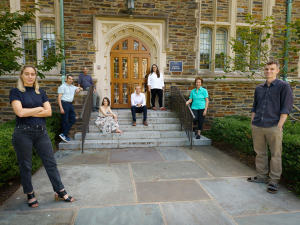New Survey of Former Federal Reserve Insiders Points to Restrained Interest Rate Outlook

Conducted by Jon Hilsenrath, a former Wall Street Journal economics writer and Visiting Scholar at Duke University, in partnership with Duke’s Department of Economics, the survey gathers views from former Federal Reserve officials and staff about the economic and outlook for the U.S. central bank.
Former Federal Reserve officials and staff anticipate higher unemployment and higher inflation in the months ahead, which could complicate decision-making at the U.S. central bank about interest rates, according to a new survey conducted in partnership with the Duke University Department of Economics. Respondents to the survey say they expect the Federal Reserve to stick with its projection of two quarter-percentage-point interest rate cuts before the end of the year, though many former officials say one rate cut or none could be more appropriate.
These insights come in advance of the central bank’s policy meeting on Tuesday and Wednesday during which officials will offer economic forecasts, the first forecasts from the Fed since President Trump announced wide-ranging import tariff policies. Likely factoring into the Fed’s decisions this week will be the federal budget bill that is now making its way through Congress.
Conducted by Jon Hilsenrath, a former Wall Street Journal economics writer and Visiting Scholar at Duke, in partnership with the Duke University Department of Economics, the survey includes insights from 22 former Fed governors, regional bank presidents and staff members collected from June 6 to June 12.
The survey found the vast majority of former officials and staff members believe the U.S. will avoid recession, with only one projecting the economy will take such a turn. However, nearly all believe recession risks remain, as well as the possibility of higher inflation.
“The economy has once again proven more resilient than many forecasters had predicted a few months ago,” Hilsenrath said. “The message here is that we aren’t out of the woods.”
One respondent pointed to a multitude of risks, including a modest slowdown in overall economic growth. “Depending on the highly uncertain evolution of trade policy, the federal budget, and unrest related to immigration policy, it's quite possible that GDP will outright contract over the coming quarters,” the respondent wrote. “The precise timing is hard to gauge. Such an outcome would mute the increase in inflation, but not much. A related risk pertains to inflation: Depending on the implementation and persistence of tariffs, inflation could come in considerably higher than envisioned in this outlook, making the policy choices for the Fed much more complicated.”
Four respondents projected that the economy could absorb higher tariffs with less disruption than many are expecting. “Firms could absorb more of the costs in margins (perhaps out of fear of retribution from the administration),” one of those four wrote. “And the drag on aggregate demand from uncertainty could be less than expected. Indeed, the "soft data" are already looking better, and the stock market is near record highs. Interest rates would probably be lower in this scenario.”
View the complete survey report for more details as well as more quotes from participants. Among the key findings from the survey:
- Unemployment and Inflation: Former officials and staff estimated the jobless rate will rise to 4.5% this year and the inflation rate will rise to 2.9%. The panel’s unemployment and inflation estimates are higher than estimates laid out by the Fed in March.
- Economic Outlook: Respondents revised down their projections for growth in gross domestic product, a broad measure of economic output. The group projected GDP growth of 1.2% in 2025, down from the Fed’s March projection of 1.7%. The ex-Fed officials see another year of below-trend GDP growth at 1.7% in 2026.
- Interest Rates in 2025: Ten former officials and staff said 0.25 percentage points in interest rate cuts this year would be appropriate. Eight people said no cuts would be appropriate. Three people said a half percentage point in cuts would be appropriate. None saw an interest rate increase or cuts in excess of half percentage point. The majority of former officials and staff said they expected the Fed to stick to its projection of half percentage point in cuts when it updates its own projections at the June meeting. The current rate is 4.3%.
- Longer Run Rates: The Fed estimates that a neutral interest rate in the long run is around 3%, meaning a fed funds rate at that level would keep output, inflation and unemployment steady at their long-run trend rates. The survey shows that former officials put a long-run neutral rate at 3.5%.
“One of the important messages in the survey is that former officials believe the Fed might not have as much room to cut interest rates in the months ahead as officials seem to believe is possible,” Hilsenrath said.
The survey asked these former officials and staff members for more than their economic projections. The group was asked to weigh in on internal deliberations taking place at the central bank about how to alter and improve its communication policies. The Fed is conducting a review of monetary policy strategy and communications that is expected to be completed this year.
In their responses, former officials and staff members offered a range of ideas about how the Fed might improve disclosure of its forecasting process. Several former officials said the central bank should publish staff forecasts for the economy to provide more context to the public about the economic backdrop underlying the central bank’s interest rate decisions, an idea recently offered by former Fed Chairman Ben Bernanke. Several respondents suggested that the Fed publish alternative scenarios for the economy beyond the baseline forecast, to give the public a better sense of the range of possible outcomes the Fed needs to consider when setting rates.
“Monetary policy is hard. It is also hard to communicate monetary policy clearly,” Hilsenrath said. “This group of former officials has a wide range of ideas about how to improve that communication process, but they have no illusions that there’s an alternative approach that will be perfect or please everyone.”
This survey is conducted leading up to the March, June, September and December meetings of the Federal Open Market Committee, with survey results released several days before each meeting. Former officials and staff were granted anonymity to encourage participation in the survey. Interested in receiving future releases from the survey? Join the mailing list.






